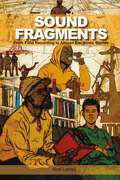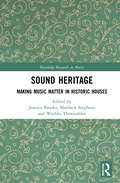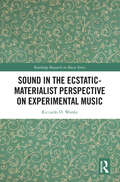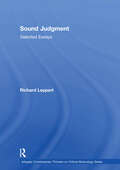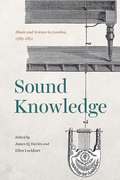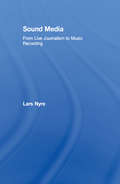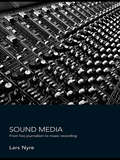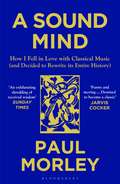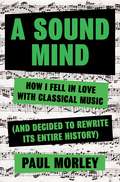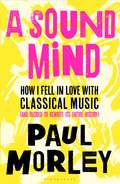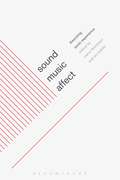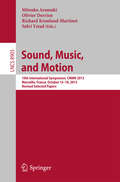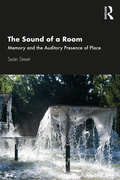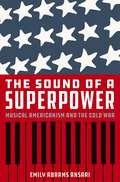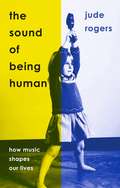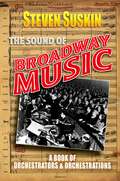- Table View
- List View
Sound Fragments: From Field Recording to African Electronic Stories (Music / Culture)
by Noel LobleyThis book is an ethnographic study of sound archives and the processes of creative decolonization that form alternative modes of archiving and curating in the 21st century. It explores the histories and afterlives of sound collections and practices at the International Library of African Music. Sound Fragments follows what happens when a colonial sound archive is repurposed and reimagined by local artists in post-apartheid South Africa. The narrative speaks to larger issues in sound studies, curatorial practices, and the reciprocity and ethics of listening to and reclaiming culture. Sound Fragments interrogates how Xhosa arts activism contributes to an expanding notion of what a sound or cultural archive could be, and where it may resonate now and in future.
Sound Heritage: Making Music Matter in Historic Houses (Routledge Research in Music)
by Jeanice Brooks Matthew Stephens Wiebke ThormählenSound Heritage is the first study of music in the historic house museum, featuring contributions from both music and heritage scholars and professionals in a richly interdisciplinary approach to central issues. It examines how music materials can be used to create narratives about past inhabitants and their surroundings - including aspects of social and cultural life beyond the activity of music making itself - and explores how music as sound, material, and practice can be more consistently and engagingly integrated into the curation and interpretation of historic houses. The volume is structured around a selection of thematic chapters and a series of shorter case studies, each focusing on a specific house, object or project. Key themes include: Different types of historic house, including the case of the composer or musician house; what can be learned from museums and galleries about the use of sound and music and what may not transfer to the historic house setting Musical instruments as part of a wider collection; questions of restoration and public use; and the demands of particular collection types such as sheet music Musical objects and pieces of music as storytelling components, and the use of music to affectively colour narratives or experiences. This is a pioneering study that will appeal to all those interested in the intersection between Music and Museum and Heritage Studies. It will also be of interest to scholars and researchers of Music History, Popular Music, Performance Studies and Material Culture.
Sound Heritage: Making Music Matter in Historic Houses (Routledge Research in Music)
by Jeanice Brooks Matthew Stephens Wiebke ThormählenSound Heritage is the first study of music in the historic house museum, featuring contributions from both music and heritage scholars and professionals in a richly interdisciplinary approach to central issues. It examines how music materials can be used to create narratives about past inhabitants and their surroundings - including aspects of social and cultural life beyond the activity of music making itself - and explores how music as sound, material, and practice can be more consistently and engagingly integrated into the curation and interpretation of historic houses. The volume is structured around a selection of thematic chapters and a series of shorter case studies, each focusing on a specific house, object or project. Key themes include: Different types of historic house, including the case of the composer or musician house; what can be learned from museums and galleries about the use of sound and music and what may not transfer to the historic house setting Musical instruments as part of a wider collection; questions of restoration and public use; and the demands of particular collection types such as sheet music Musical objects and pieces of music as storytelling components, and the use of music to affectively colour narratives or experiences. This is a pioneering study that will appeal to all those interested in the intersection between Music and Museum and Heritage Studies. It will also be of interest to scholars and researchers of Music History, Popular Music, Performance Studies and Material Culture.
Sound in the Ecstatic-Materialist Perspective on Experimental Music (Routledge Research in Music)
by Riccardo D. WankeWhat does a one hour contemporary orchestral piece by Georg Friedrich Haas have in common with a series of glitch-noise electronic tracks by Pan Sonic? This book proposes that, despite their differences, they share a particular understanding of sound that is found across several quite distinct genres of contemporary art music: the ecstatic-materialist perspective. Sound in the ecstatic-materialist perspective is considered as a material mass or element, unfolding in time, encountered by a listener, for whom the experience of that sound exceeds the purely sonic without becoming entirely divorced from its materiality. It is "material" by virtue of the focus on the texture, consistency, and density of sound; it is "ecstatic" in the etymological sense, that is to say that the experience of this sound involves an instability; an inclination to depart from material appearance, an ephemeral and transitory impulse in the very perception of sound to something beyond – but still related to – it. By examining musical pieces from spectralism to electroacoustic domains, from minimalism to glitch electronica and dubstep, this book identifies the key intrinsic characteristics of this musical perspective. To fully account for this perspective on sonic experience, listener feedback and interviews with composers and performers are also incorporated. Sound in the ecstatic-materialist perspective is the common territory where composers, sound artists, performers, and listeners converge.
Sound in the Ecstatic-Materialist Perspective on Experimental Music (Routledge Research in Music)
by Riccardo D. WankeWhat does a one hour contemporary orchestral piece by Georg Friedrich Haas have in common with a series of glitch-noise electronic tracks by Pan Sonic? This book proposes that, despite their differences, they share a particular understanding of sound that is found across several quite distinct genres of contemporary art music: the ecstatic-materialist perspective. Sound in the ecstatic-materialist perspective is considered as a material mass or element, unfolding in time, encountered by a listener, for whom the experience of that sound exceeds the purely sonic without becoming entirely divorced from its materiality. It is "material" by virtue of the focus on the texture, consistency, and density of sound; it is "ecstatic" in the etymological sense, that is to say that the experience of this sound involves an instability; an inclination to depart from material appearance, an ephemeral and transitory impulse in the very perception of sound to something beyond – but still related to – it. By examining musical pieces from spectralism to electroacoustic domains, from minimalism to glitch electronica and dubstep, this book identifies the key intrinsic characteristics of this musical perspective. To fully account for this perspective on sonic experience, listener feedback and interviews with composers and performers are also incorporated. Sound in the ecstatic-materialist perspective is the common territory where composers, sound artists, performers, and listeners converge.
Sound Judgment: Selected Essays (Ashgate Contemporary Thinkers On Critical Musicology Ser.)
by Richard LeppertThe essays in Sound Judgment span the full career of Richard Leppert, from his earliest to work that appears here for the first time, on subjects drawn from early modernity to the present concerning music both popular and classical, European and North American. Noted for his path-breaking interdisciplinary scholarship on music and visual culture, the collection includes key essays on music's visualization in art practices in virtually all visual media, including film. The fourteen essays comprising this volume demonstrate Leppert's many contributions to critical musicology, particularly in the areas of aesthetics as well as social and intellectual history, all of it grounded in a heterodox body of critical and cultural theory, with the work of Theodor W. Adorno particularly noteworthy. The collection is preceded by an introduction in which Leppert traces his intellectual development, defined in large part by the social, cultural, and political upheavals of the 1960s and their aftermath both in the academy and in society at large.
Sound Judgment: Selected Essays (Ashgate Contemporary Thinkers On Critical Musicology Ser.)
by Richard LeppertThe essays in Sound Judgment span the full career of Richard Leppert, from his earliest to work that appears here for the first time, on subjects drawn from early modernity to the present concerning music both popular and classical, European and North American. Noted for his path-breaking interdisciplinary scholarship on music and visual culture, the collection includes key essays on music's visualization in art practices in virtually all visual media, including film. The fourteen essays comprising this volume demonstrate Leppert's many contributions to critical musicology, particularly in the areas of aesthetics as well as social and intellectual history, all of it grounded in a heterodox body of critical and cultural theory, with the work of Theodor W. Adorno particularly noteworthy. The collection is preceded by an introduction in which Leppert traces his intellectual development, defined in large part by the social, cultural, and political upheavals of the 1960s and their aftermath both in the academy and in society at large.
Sound Knowledge: Music and Science in London, 1789-1851
by James Q. Davies Ellen LockhartWhat does it mean to hear scientifically? What does it mean to see musically? This volume uncovers a new side to the long nineteenth century in London, a hidden history in which virtuosic musical entertainment and scientific discovery intersected in remarkable ways. Sound Knowledge examines how scientific truth was accrued by means of visual and aural experience, and, in turn, how musical knowledge was located in relation to empirical scientific practice. James Q. Davies and Ellen Lockhart gather work by leading scholars to explore a crucial sixty-year period, beginning with Charles Burney’s ambitious General History of Music, a four-volume study of music around the globe, and extending to the Great Exhibition of 1851, where musical instruments were assembled alongside the technologies of science and industry in the immense glass-encased collections of the Crystal Palace. Importantly, as the contributions show, both the power of science and the power of music relied on performance, spectacle, and experiment. Ultimately, this volume sets the stage for a new picture of modern disciplinarity, shining light on an era before the division of aural and visual knowledge.
Sound Knowledge: Music and Science in London, 1789-1851
by James Q. Davies and Ellen Lockhart Ellen LockhartWhat does it mean to hear scientifically? What does it mean to see musically? This volume uncovers a new side to the long nineteenth century in London, a hidden history in which virtuosic musical entertainment and scientific discovery intersected in remarkable ways. Sound Knowledge examines how scientific truth was accrued by means of visual and aural experience, and, in turn, how musical knowledge was located in relation to empirical scientific practice. James Q. Davies and Ellen Lockhart gather work by leading scholars to explore a crucial sixty-year period, beginning with Charles Burney’s ambitious General History of Music, a four-volume study of music around the globe, and extending to the Great Exhibition of 1851, where musical instruments were assembled alongside the technologies of science and industry in the immense glass-encased collections of the Crystal Palace. Importantly, as the contributions show, both the power of science and the power of music relied on performance, spectacle, and experiment. Ultimately, this volume sets the stage for a new picture of modern disciplinarity, shining light on an era before the division of aural and visual knowledge.
Sound Knowledge: Music and Science in London, 1789-1851
by James Q. Davies and Ellen Lockhart Ellen LockhartWhat does it mean to hear scientifically? What does it mean to see musically? This volume uncovers a new side to the long nineteenth century in London, a hidden history in which virtuosic musical entertainment and scientific discovery intersected in remarkable ways. Sound Knowledge examines how scientific truth was accrued by means of visual and aural experience, and, in turn, how musical knowledge was located in relation to empirical scientific practice. James Q. Davies and Ellen Lockhart gather work by leading scholars to explore a crucial sixty-year period, beginning with Charles Burney’s ambitious General History of Music, a four-volume study of music around the globe, and extending to the Great Exhibition of 1851, where musical instruments were assembled alongside the technologies of science and industry in the immense glass-encased collections of the Crystal Palace. Importantly, as the contributions show, both the power of science and the power of music relied on performance, spectacle, and experiment. Ultimately, this volume sets the stage for a new picture of modern disciplinarity, shining light on an era before the division of aural and visual knowledge.
Sound Knowledge: Music and Science in London, 1789-1851
What does it mean to hear scientifically? What does it mean to see musically? This volume uncovers a new side to the long nineteenth century in London, a hidden history in which virtuosic musical entertainment and scientific discovery intersected in remarkable ways. Sound Knowledge examines how scientific truth was accrued by means of visual and aural experience, and, in turn, how musical knowledge was located in relation to empirical scientific practice. James Q. Davies and Ellen Lockhart gather work by leading scholars to explore a crucial sixty-year period, beginning with Charles Burney’s ambitious General History of Music, a four-volume study of music around the globe, and extending to the Great Exhibition of 1851, where musical instruments were assembled alongside the technologies of science and industry in the immense glass-encased collections of the Crystal Palace. Importantly, as the contributions show, both the power of science and the power of music relied on performance, spectacle, and experiment. Ultimately, this volume sets the stage for a new picture of modern disciplinarity, shining light on an era before the division of aural and visual knowledge.
Sound Media: From Live Journalism to Music Recording
by Lars NyreSound Media considers how music recording, radio broadcasting and muzak influence people's daily lives and introduces the many and varied creative techniques that have developed in music and journalism throughout the twentieth century. Lars Nyre starts with the contemporary cultures of sound media, and works back to the archaic soundscapes of the 1870s. The first part of the book devotes five chapters to contemporary digital media, and presents the internet, the personal computer, digital radio (news and talk) and various types of loudspeaker media (muzak, DJ-ing, clubbing and PA systems). The second part examines the historical accumulation of techniques and sounds in sound media, and presents multitrack music in the 1960s, the golden age of radio in the 1950s and back to the 1930s, microphone recording of music in the 1930s, the experimental phase of wireless radio in the 1910s and 1900s, and the invention of the gramophone and phonograph in the late nineteenth century. Sound Media includes a soundtrack CD with thirty-six examples from broadcasting and music recording in Europe and the USA, from Edith Piaf to Sarah Cox, and is richly illustrated with figures, timelines and technical drawings.
Sound Media: From Live Journalism to Music Recording
by Lars NyreSound Media considers how music recording, radio broadcasting and muzak influence people's daily lives and introduces the many and varied creative techniques that have developed in music and journalism throughout the twentieth century. Lars Nyre starts with the contemporary cultures of sound media, and works back to the archaic soundscapes of the 1870s. The first part of the book devotes five chapters to contemporary digital media, and presents the internet, the personal computer, digital radio (news and talk) and various types of loudspeaker media (muzak, DJ-ing, clubbing and PA systems). The second part examines the historical accumulation of techniques and sounds in sound media, and presents multitrack music in the 1960s, the golden age of radio in the 1950s and back to the 1930s, microphone recording of music in the 1930s, the experimental phase of wireless radio in the 1910s and 1900s, and the invention of the gramophone and phonograph in the late nineteenth century. Sound Media includes a soundtrack CD with thirty-six examples from broadcasting and music recording in Europe and the USA, from Edith Piaf to Sarah Cox, and is richly illustrated with figures, timelines and technical drawings.
A Sound Mind: How I Fell in Love with Classical Music (and Decided to Rewrite its Entire History)
by Paul Morley'An alternately funny and moving book about the most important art form on Planet Earth. Destined to become a classic (pun intended)' Jarvis CockerMusic critic and writer Paul Morley weaves together memoir and history in a spiralling tale that establishes classical music as the most rebellious genre of all. Paul Morley had stopped being surprised by modern pop music and found himself retreating into the sounds of artists he loved when, as an emerging music journalist in the 70s, he wrote for NME. But not wishing to give in to dreary nostalgia, endlessly circling back to the bands he wrote about in the past, he went searching for something new, rare and wondrous – and found it in classical music. A soaring polemic, a grumpy reflection on modern rock, and a fan's love note, A Sound Mind rejects the idea that classical music is establishment; old; a drag. Instead, the book reveals this genre to be the most exciting and varied in music. A Sound Mind is a multi-layered memoir of Morley's shifting musical tastes, but it is also a compelling history of classical music that reveals the genre's rich and often deviant past – and, hopefully, future. Like a conductor, Morley weaves together timelines and timeframes in an orchestral narrative that declares the transformative and resilient power of classical music from Bach to Shostakovich, Brahms to Birtwistle, Mozart to Cage, travelling from eighteenth century salons to the modern age of Spotify.
A Sound Mind: How I Fell in Love with Classical Music (and Decided to Rewrite its Entire History)
by Paul MorleyFor readers of Mozart in the Jungle and Year of Wonder, a new history of and guide to classical music. Paul Morley made his name as a journalist covering the rock and pop of the 1970s and 1980s. But as his career progressed, he found himself drawn toward developing technologies, streaming platforms, and, increasingly, the music from the past that streaming services now made available. Suddenly able to access every piece Mozart or Bach had ever written and to curate playlists that worked with these musicians' themes across different performers, composers, and eras, he began to understand classical music in a whole new way and to believe that it was music at its most dramatic and revealing. In A Sound Mind, Morley takes readers along on his journey into the history and future of classical music. His descriptions, explanations, and guidance make this seemingly arcane genre more friendly to listeners and show the music's power, depth, and timeless beauty. In Morley's capable hands, the history of the classical genre is shown to be the history of all music, with these long-ago pieces influencing everyone from jazz greats to punk rockers and the pop musicians of today.
A Sound Mind: How I Fell in Love with Classical Music (and Decided to Rewrite its Entire History)
by Paul Morley'An alternately funny and moving book about the most important art form on Planet Earth. Destined to become a classic (pun intended)' Jarvis CockerMusic critic and writer Paul Morley weaves together memoir and history in a spiralling tale that establishes classical music as the most rebellious genre of all. Paul Morley had stopped being surprised by modern pop music and found himself retreating into the sounds of artists he loved when, as an emerging music journalist in the 70s, he wrote for NME. But not wishing to give in to dreary nostalgia, endlessly circling back to the bands he wrote about in the past, he went searching for something new, rare and wondrous – and found it in classical music. A soaring polemic, a grumpy reflection on modern rock, and a fan's love note, A Sound Mind rejects the idea that classical music is establishment; old; a drag. Instead, the book reveals this genre to be the most exciting and varied in music. A Sound Mind is a multi-layered memoir of Morley's shifting musical tastes, but it is also a compelling history of classical music that reveals the genre's rich and often deviant past – and, hopefully, future. Like a conductor, Morley weaves together timelines and timeframes in an orchestral narrative that declares the transformative and resilient power of classical music from Bach to Shostakovich, Brahms to Birtwistle, Mozart to Cage, travelling from eighteenth century salons to the modern age of Spotify.
Sound, Music, Affect: Theorizing Sonic Experience
by Ian Biddle Marie ThompsonSound, Music, Affect features brand new essays that bring together the burgeoning developments in sound studies and affect studies. The first section sets out key methodological and theoretical concerns, focussing on the relationships between affective models and sound. The second section deals with particular musical case studies, exploring how reference to affect theory might change or reshape some of the ways we are able to make sense of musical materials. The third section examines the politics and practice of sonic disruption: from the notion of noise as 'prophecy', to the appropriation of 'bad vibes' for pleasurable aesthetic and affective experiences. And the final section engages with some of the ways in which affect can help us understand the politics of chill, relaxation and intimacy as sonic encounters. The result is a rich and multifaceted consideration of sound, music and the affective, from scholars with backgrounds in cultural theory, history, literary studies, media studies, architecture, philosophy and musicology.
Sound, Music, Affect: Theorizing Sonic Experience
by MARIE THOMPSON AND IAN BIDDLESound, Music, Affect features brand new essays that bring together the burgeoning developments in sound studies and affect studies. The first section sets out key methodological and theoretical concerns, focussing on the relationships between affective models and sound. The second section deals with particular musical case studies, exploring how reference to affect theory might change or reshape some of the ways we are able to make sense of musical materials. The third section examines the politics and practice of sonic disruption: from the notion of noise as 'prophecy', to the appropriation of 'bad vibes' for pleasurable aesthetic and affective experiences. And the final section engages with some of the ways in which affect can help us understand the politics of chill, relaxation and intimacy as sonic encounters. The result is a rich and multifaceted consideration of sound, music and the affective, from scholars with backgrounds in cultural theory, history, literary studies, media studies, architecture, philosophy and musicology.
Sound, Music, and Motion: 10th International Symposium, CMMR 2013, Marseille, France, October 15-18, 2013. Revised Selected Papers (Lecture Notes in Computer Science #8905)
by Mitsuko Aramaki Olivier Derrien Richard Kronland-Martinet Sølvi YstadThis book constitutes the thoroughly refereed post-conference proceedings of the 10th International Symposium on Computer Music Modeling and Retrieval, CMMR 2013, held in Marseille, France, in October 2013. The 38 conference papers presented were carefully reviewed and selected from 94 submissions. The chapters reflect the interdisciplinary nature of this conference with following topics: augmented musical instruments and gesture recognition, music and emotions: representation, recognition, and audience/performers studies, the art of sonification, when auditory cues shape human sensorimotor performance, music and sound data mining, interactive sound synthesis, non-stationarity, dynamics and mathematical modeling, image-sound interaction, auditory perception and cognitive inspiration, and modeling of sound and music computational musicology.
The Sound of a Room: Memory and the Auditory Presence of Place
by Seán StreetWhat does a place sound like – and how does the sound of place affect our perceptions, experiences, and memories? The Sound of a Room takes a poetic and philosophical approach to exploring these questions, providing a thoughtful investigation of the sonic aesthetics of our lived environments. Moving through a series of location-based case studies, the author uses his own field recordings as the jumping-off point to consider the underlying questions of how sonic environments interact with our ideas of self, sense of creativity, and memories. Advocating an awareness born of deep listening, this book offers practical and poetic insights for researchers, practitioners, and students of sound.
The Sound of a Room: Memory and the Auditory Presence of Place
by Seán StreetWhat does a place sound like – and how does the sound of place affect our perceptions, experiences, and memories? The Sound of a Room takes a poetic and philosophical approach to exploring these questions, providing a thoughtful investigation of the sonic aesthetics of our lived environments. Moving through a series of location-based case studies, the author uses his own field recordings as the jumping-off point to consider the underlying questions of how sonic environments interact with our ideas of self, sense of creativity, and memories. Advocating an awareness born of deep listening, this book offers practical and poetic insights for researchers, practitioners, and students of sound.
The Sound of a Superpower: Musical Americanism and the Cold War
by Emily Abrams AnsariClassical composers seeking to create an American sound enjoyed unprecedented success during the 1930s and 1940s. Aaron Copland, Roy Harris, Howard Hanson and others brought national and international attention to American composers for the first time in history. In the years after World War II, however, something changed. The prestige of musical Americanism waned rapidly as anti-Communists made accusations against leading Americanist composers. Meanwhile a method of harmonic organization that some considered more Cold War-appropriate--serialism--began to rise in status. For many composers and historians, the Cold War had effectively "killed off" musical Americanism. In The Sound of a Superpower: Musical Americanism and the Cold War, Emily Abrams Ansari offers a fuller, more nuanced picture of the effect of the Cold War on Americanist composers. The ideological conflict brought both challenges and opportunities. Some Americanist composers struggled greatly in this new artistic and political environment. Those with leftist politics sensed a growing gap between the United States that their music imagined and the aggressive global superpower that their nation seemed to be becoming. But these same composers would find unique opportunities to ensure the survival of musical Americanism thanks to the federal government, which wanted to use American music as a Cold War propaganda tool. By serving as advisors to cultural diplomacy programs and touring as artistic ambassadors, the Americanists could bring their now government-backed music to new global audiences. Some with more right-wing politics, meanwhile, would actually flourish in the new ideological environment, by aligning their music with Cold War conceptions of American identity. The Americanists' efforts to safeguard the reputation of their style would have significant consequences. Ultimately, Ansari shows, they effected a rebranding of musical Americanism, with consequences that remain with us today.
The Sound of a Superpower: Musical Americanism and the Cold War
by Emily Abrams AnsariClassical composers seeking to create an American sound enjoyed unprecedented success during the 1930s and 1940s. Aaron Copland, Roy Harris, Howard Hanson and others brought national and international attention to American composers for the first time in history. In the years after World War II, however, something changed. The prestige of musical Americanism waned rapidly as anti-Communists made accusations against leading Americanist composers. Meanwhile a method of harmonic organization that some considered more Cold War-appropriate--serialism--began to rise in status. For many composers and historians, the Cold War had effectively "killed off" musical Americanism. In The Sound of a Superpower: Musical Americanism and the Cold War, Emily Abrams Ansari offers a fuller, more nuanced picture of the effect of the Cold War on Americanist composers. The ideological conflict brought both challenges and opportunities. Some Americanist composers struggled greatly in this new artistic and political environment. Those with leftist politics sensed a growing gap between the United States that their music imagined and the aggressive global superpower that their nation seemed to be becoming. But these same composers would find unique opportunities to ensure the survival of musical Americanism thanks to the federal government, which wanted to use American music as a Cold War propaganda tool. By serving as advisors to cultural diplomacy programs and touring as artistic ambassadors, the Americanists could bring their now government-backed music to new global audiences. Some with more right-wing politics, meanwhile, would actually flourish in the new ideological environment, by aligning their music with Cold War conceptions of American identity. The Americanists' efforts to safeguard the reputation of their style would have significant consequences. Ultimately, Ansari shows, they effected a rebranding of musical Americanism, with consequences that remain with us today.
The Sound of Being Human: How Music Shapes Our Lives
by Jude Rogers'Too often we treat popular music as wallpaper surrounding us as we live our lives. Jude Rogers shows the emotional and cerebral heft such music can have. It's a personal journey which becomes universal. Fascinating' Ian Rankin'Moving and absorbing, The Sound of Being Human mixes memoir, analysis, anecdote and personal chronicle into a mosaic that evokes what music means to the individual and the human tribe. A candid, beautiful read' Stuart MaconieThe Sound of Being Human explores, in detail, why music plays such a deep-rooted role in so many lives, from before we are born to our last days. At its heart is Jude's own story: how songs helped her wrestle with the grief of losing her father at age five; concoct her own sense of self as a lonely adolescent; sky-rocket her relationships, both real and imagined, in the flushes of early womanhood, propel her own journey into working life, adulthood and parenthood, and look to the future.Shaped around twelve songs, ranging from ABBA's 'Super Trouper' to Neneh Cherry's 'Buffalo Stance', Kraftwerk's 'Radioactivity' to Martha Reeves and the Vandellas' 'Heat Wave', the book combines memoir and historical, scientific and cultural enquiry to show how music can shape different versions of ourselves; how we rely upon music for comfort, for epiphanies, and for sexual and physical connection; how we grow with songs, and songs grow inside us, helping us come to terms with grief, getting older and powerful memories. It is about music's power to help us tell our own stories, whatever they are, and make them sing.
The Sound of Broadway Music: A Book of Orchestrators and Orchestrations
by Steven SuskinBroadway's top orchestrators - Robert Russell Bennett, Don Walker, Philip J. Lang, Jonathan Tunick - are names well known to musical theatre fans, but few people understand precisely what the orchestrator does. The Sound of Broadway Music is the first book ever written about these unsung stars of the Broadway musical whose work is so vital to each show's success. The book examines the careers of Broadway's major orchestrators and follows the song as it travels from the composer's piano to the orchestra pit. Steven Suskin has meticulously tracked down thousands of original orchestral scores, piecing together enigmatic notes and notations with long-forgotten documents and current interviews with dozens of composers, producers, conductors and arrangers. The information is separated into three main parts: a biographical section which gives a sense of the life and world of twelve major theatre orchestrators, as well as incorporating briefer sections on another thirty arrangers and conductors; a lively discussion of the art of orchestration, written for musical theatre enthusiasts (including those who do not read music); a biographical section which gives a sense of the life and world of twelve major theatre orchestrators, as well as incorporating briefer sections on another thirty arrangers and conductors; and an impressive show-by-show listing of more than seven hundred musicals, in many cases including a song-by-song listing of precisely who orchestrated what along with relevant comments from people involved with the productions. Stocked with intriguing facts and juicy anecdotes, many of which have never before appeared in print, The Sound of Broadway Music brings fascinating and often surprising new insight into the world of musical theatre.
